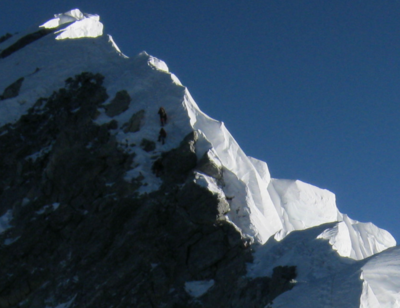


The Hillary Step was a 40-foot vertical rock face that sits 8,790 metres (28,839 ft) above sea level.[1] It was located near the summit of Mount Everest. Located on the Southeast ridge, halfway between the "South Summit" and the True Summit, the Hillary Step was the most technically difficult part of the typical Nepal-side Everest climb[2] and the last real challenge before reaching the top of the mountain.[3] The rock face was destroyed by an earthquake that struck the region in 2015.[4]
The Hillary Step has a reputation among climbers for its 3,000-metre (10,000 ft) and 2,400-metre (8,000 ft) drops on the ascent.[5][6] Without a guide, the climb is Class 4 and in the death zone.[7] One expedition noted that climbing the Hillary Step was "strenuous" and offered little to no escape from the changing elements.[8]
Heavy snowfall events can allow climbers the opportunity to bypass Hillary, by way of snow and ice climbing.[9]
The Hillary Step has claimed its share of lives, due to its strenuous conditions and unpredictable, rapidly changing weather. Author Anatoli Boukreev found the body of Bruce Herrod hanging from ropes at the base of the step in 1996, according to his book The Climb.[10]
- ^ Vajpai, Arjun (10 November 2010). ON TOP OF WORLD: My Everest Adventure. Penguin UK. ISBN 9788184753042.
- ^ "Into Thin Air - Photos". intothinairmcwilliams.wikispaces.com. Archived from the original on 25 April 2018. Retrieved 20 May 2017.
- ^ Kumar, Ravindra (14 February 2017). Many Everests: An Inspiring Journey of Transforming Dreams Into Reality. Bloomsbury Publishing. ISBN 9789386141347.
- ^ Cite error: The named reference
Bouchardwas invoked but never defined (see the help page). - ^ Marks, Andrea. "Because It's Not There: Climbers May Face Danger If Everest's Hillary Step Collapsed". Scientific American.
- ^ Isserman, Maurice; Weaver, Stewart; Molenaar, Dee (1 February 2010). Fallen Giants: A History of Himalayan Mountaineering from the Age of Empire to the Age of Extremes. Yale University Press. ISBN 978-0300164206. Retrieved 22 May 2017 – via Google Books.
- ^ "Is an Everest Climb "Technical"?". OutsideOnline.com. 30 March 2010. Retrieved 28 May 2017.
- ^ Carter, H. Adams (1 January 1991). American Alpine Journal, 1991. The Mountaineers Books. ISBN 9780930410469.
- ^ Hamill, Mike (4 May 2012). Climbing the Seven Summits: A Comprehensive Guide to the Continents' Highest Peaks. The Mountaineers Books. ISBN 9781594856495.
- ^ Boukreev, Anatoli; DeWalt, G. Weston (22 September 2015). The Climb: Tragic Ambitions on Everest. St. Martin's Press. ISBN 9781250099822.